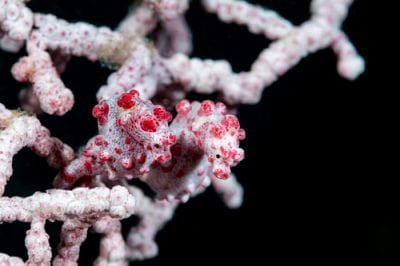
The vast expanse of our oceans holds a multitude of secrets, and many marine species remain shrouded in mystery. Seahorses, with their unique body shape and prehensile tails, are a captivating example. But their cryptic nature makes studying them a challenge.
However, thanks to diligent observers, seahorses are not only being discovered in new habitats and expanded geographic areas but are also being found at new oceanic depths.
Researchers from Project Seahorse – a marine conservation team based at the University of British Columbia (UBC) and the Zoological Society of London (ZSL) – identified and reviewed new findings related to 35 of the 46 seahorse species found worldwide, all published by citizen scientists using the iSeahorse program, which is part of the iNaturalist family.
iSeahorse Program
Now ordinary people like you and me can play a crucial role in marine conservation.
The iSeahorse program allows community or citizen scientists (members of the public and non-professional or amateur researchers) to provide information about their sightings of seahorses in the wild. By posting on the website, they provide information about which seahorse species they saw, when and where they saw them, their habitat, and their depth. They are also asked to provide photographic evidence if possible.
iSeahorse provides a platform for anyone, from experienced divers to beachcombing enthusiasts, to contribute valuable data. By submitting their seahorse sightings and observations, citizen scientists are helping to bridge the gap in our knowledge about these elusive creatures.
iSeahorse: A Treasure Trove of New Discoveries
Researchers recently analyzed data collected by iSeahorse from 2013 to 2022, focusing on 35 of the 46 known seahorse species. The results were nothing short of astonishing:
- Expanded Territories: iSeahorse data revealed expanded geographic ranges for 7 seahorse species, providing a more accurate picture of their distribution.
- Revealed Habitat: The project documented new types of habitat for 24 amazing species, providing valuable information about their preferred environments.
- Deeper Dives: Researchers identified sightings of 14 species beyond their previously recorded depth range, highlighting the need for further exploration.
- Sex and Seasonality: iSeahorse data provided new information on sex ratios for 15 species and the seasonality of pregnancy for 11 species, crucial details for population management.
“It was fascinating that iSeahorse data extended the known breeding season for five species,” added Camins. “In the tropics, seahorses were reported to breed every month. Surprisingly, this was also true for Asian species in the northern hemisphere, although with greater reproduction in the spring.”
Stay Always Informed
Join our communities to instantly receive the most important news, reports, and analysis from the aquaculture industry.
“The new findings will improve global conservation assessments of species on the IUCN Red List of Threatened Species worldwide,” said Elsa Camins Martínez, then a master’s student at the Institute for the Oceans and Fisheries at UBC.
Coleman’s Pygmy Seahorse: A Citizen Science Case Study
The story of Coleman’s pygmy seahorse (Hippocampus colemani) perfectly exemplifies the power of iSeahorse. Citizen scientists revealed a more diverse habitat, a geographic range thousands of square kilometers larger, and a shallower depth than previously known for this tiny wonder.
Many of the observations of Hippocampus satomiae were also outside the reported distribution area on the IUCN Red List, suggesting that its distribution area is considerably larger than previously thought.
“When comparing habitat types reported in iSeahorse with those in the IUCN Red List assessment for each species, we found new habitats for 80 percent of the species,” said Dr. Amanda Vincent, professor at UBC, co-founder, and director of Project Seahorse. “We found new habitats for Hippocampus comes, Hippocampus histrix, H. kuda, Hippocampus kelloggi, and Hippocampus spinossisimus, each with five or six new habitats.”

iSeahorse: A Model for Marine Conservation
The success of iSeahorse demonstrates the immense potential of citizen science in marine conservation. By empowering the public to participate in research, we can gather invaluable data that would be difficult or costly to obtain using traditional methods.
Dr. Vincent is proud of the iSeahorse website. “We engage with observers in Southeast Asia, Australia, the Caribbean, and Europe (areas with high diving activity) and greatly benefit from being part of the iNaturalist portfolio. As the first biologist to conduct underwater seahorse research, I am excited about how participant-provided information is helping to expand our understanding of many species. Even for a commonly studied species like tiger tail seahorses (Hippocampus comes), iSeahorse observations came from outside the IUCN Red List distribution area, with new discoveries in Thailand and Indonesia.”
The Call to Action: Become a Citizen Scientist for Seahorses!
“With the help of contributors from our community, we were able to gather information on a much larger scale,” says Heather Koldewey, co-founder of Project Seahorse, senior marine technical advisor at ZSL, and co-author of the article. “This study has demonstrated the value of community science in advancing seahorse knowledge by helping to close gaps. Seahorses are the type of fascinating species that benefit from community science, as they are cryptic enough to make formal research challenging. The results of all these efforts demonstrate the importance of promoting marine community science and the significant role it can play in conservation, generating knowledge, and mobilizing engagement and action.”
iSeahorse is an excellent example of how anyone can make a real difference in our oceans. Whether you are an experienced diver or simply enjoy exploring the coast, consider joining this exciting project. By sharing your seahorse sightings, you can help uncover the mysteries of these captivating creatures and ensure their survival for future generations.
Project Seahorse
Project Seahorse is a leader in marine conservation, making discoveries & and collaborating globally to take effective action for seahorses and their seas. The organization cares for seahorses as flagship animals, conducting cutting-edge research on protected areas, fisheries and wildlife trade… , and applying the new knowledge to produce highly effective conservation interventions. Project Seahorse has won many international awards and honours, and works with researchers, governments, conservation groups and local communities worldwide. Project Seahorse is based at the University of British Columbia, Canada, and Zoological Society of London, UK. Visit www.projectseahorse.org for more information.
ZSL
Founded in 1826, ZSL is an international conservation charity, driven by science, working to restore wildlife in the UK and around the world; by protecting critical species, restoring ecosystems, helping people and wildlife live together and inspiring support for nature. Through our leading conservation zoos, London and Whipsnade, we bring people closer to nature and use our expertise to protect wildlife today, while inspiring a lifelong love of animals in the conservationists of tomorrow. Visit www.zsl.org for more information.
Contact
Elsa Camins
Project Seahorse, Institute for Oceans and Fisheries, The University of British Columbia, Vancouver, BC V6T 1Z4, Canada.
Email: e.camins@oceans.ubc.ca
Reference (open access)
Camins, E., Stanton, L. M., Correia, M., Foster, S. J., Koldewey, H. J., & J. Vincent, A. C. Advances in life-history knowledge for 35 seahorse species from community science. Journal of Fish Biology. https://doi.org/10.1111/jfb.15699
Note: Article prepared using information from the press release and the scientific paper.
Editor at the digital magazine AquaHoy. He holds a degree in Aquaculture Biology from the National University of Santa (UNS) and a Master’s degree in Science and Innovation Management from the Polytechnic University of Valencia, with postgraduate diplomas in Business Innovation and Innovation Management. He possesses extensive experience in the aquaculture and fisheries sector, having led the Fisheries Innovation Unit of the National Program for Innovation in Fisheries and Aquaculture (PNIPA). He has served as a senior consultant in technology watch, an innovation project formulator and advisor, and a lecturer at UNS. He is a member of the Peruvian College of Biologists and was recognized by the World Aquaculture Society (WAS) in 2016 for his contribution to aquaculture.




